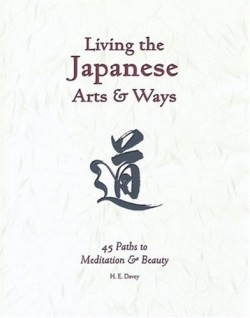Living the Japanese Arts & Ways
45 Paths to Meditation & Beauty
A spiritual path can emerge from learning Japanese calligraphy, flower arranging, tea ceremony, or martial arts. While millions of people around the world begin these practices, few go deep enough to experience the spiritual dimensions that are possible. How-to guides rarely cover enlightenment. This one, however, brings forty-five conceptsÃ’the underpinning of all traditional Japanese cultural practicesÃ’into focus. Understanding these Ways, the essence of living, points readers toward asking profound questions, getting inspired to take up a practice, and awakening to ultimate reality.
The author illustrates how Japanese arts, followed with the right attitudes, can turn ongoing practice into moving meditation: “The Ways involve activity, and so their underlying principles can be discovered only by doing.” Continued practice eventually embodies these essential universal truths in the body and mind of the practitioner, to achieve harmonious and effective ways of being in the world. A lifetime of mindful practice creates a physical understanding of, for example, in-yo, the Japanese equivalent of yin-yang, “the basic, complementary, and inseparable dualism evidenced in the relative world.” Davey explains such aesthetic and spiritual terms at length, including some that Westerners may think they knowÃ’like ki (life energy) or Do (the Way).
Connecting with the deepest possibilities in Japanese arts is a tall order. Davey is one Westerner able to deliver. He learned Japanese martial arts from his father and has practiced since he was five. He is now the highest-ranking American in the Nihon Jujutsu and Kobudo divisions of the Kokusai Budoin. This federation, sponsored by the Japanese Imperial Family, has conferred on him the title of Kyoshi or “Master’s Certificate,” equivalent to a sixth- to eighth-degree black belt. He is currently President of the Sennin Foundation, sponsor of Michi (“The Way”) Online, an Internet magazine. In addition, he practices and teaches Japanese calligraphy and brush painting as well as a Japanese form of yoga at the highest levels. He has written books on the particulars of these Ways.
Because this learning must be experiential, there’s much that won’t be mastered by reading alone. However, the book offers some exercises called “experiments” to physically learn about the human center of gravity (hara), calmness (ochitsuki), and ki. An appendix provides sources for finding a good sensei (teacher). This holistic perspective presents a practical base of philosophy-in-action for those who want to take their Japanese arts beyond surface understanding.
Reviewed by
Bobbye Middendorf
Disclosure: This article is not an endorsement, but a review. The publisher of this book provided free copies of the book to have their book reviewed by a professional reviewer. No fee was paid by the publisher for this review. Foreword Reviews only recommends books that we love. Foreword Magazine, Inc. is disclosing this in accordance with the Federal Trade Commission’s 16 CFR, Part 255.

